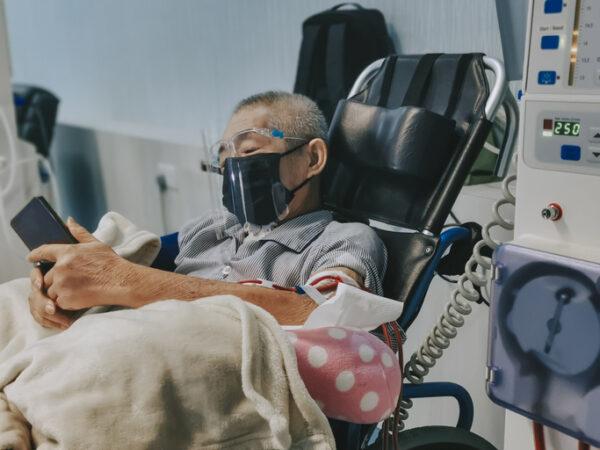
Chronic disease management can be extremely complex, as care coordination across teams poses many challenges, like fragmented care, siloed data, and a lack of interoperability between health systems. Patients with conditions like chronic kidney disease (CKD) often have multiple providers on their care team in addition to nephrologists, including primary care providers, subspecialists in endocrinology and cardiology, social workers, dieticians, and pharmacists. Though there are many benefits to the holistic approach offered by working with many specialists, a lack of alignment and coordination between these professionals can result in fragmented care and poor outcomes.
Interdisciplinary coordination, a model that encourages healthcare professionals across the continuum to engage in a comprehensive approach to patient care, is necessary to ensure chronic disease patients receive the best treatment possible. This model is supported through mechanisms of collaboration like innovative technologies and electronic health record (EHR) sharing within health systems that enhance communication and decision-making. By focusing on the whole patient and coordinating various aspects of their treatment plan, providers can personalize care to individuals, increasing their engagement to promote improved disease management and leading to longer, fuller lives.
Interdisciplinary care has been linked to increased patient safety, lower hospitalization rates, and a reduction in medical errors. In the case of kidney care, it enables nephrologists to focus on managing CKD and ESKD instead of coordinating other aspects of care.
Here are a few benefits of adopting an interdisciplinary approach to chronic disease management:
Promoting a holistic approach to care
Chronic disease patients – who make up nearly 40% of the U.S. population – require complex treatment plans that involve elements of several specialties. This care can be time-consuming, with the average chronic disease patient requiring 828 hours per year – 3.5 hours per day – of medical care that physician time constraints often prohibit. Further, when these conditions are not treated in tandem and inter-team coordination is poor, patients experience more frequent and longer hospitalizations. In an interdisciplinary care model, providers take a patient-focused approach to achieve a unified goal of ensuring plans are comprehensive and address a myriad of needs.
When providers are able to address care more holistically, they can identify trends across different areas of an individual’s health to better manage chronic disease symptoms. This is particularly important because physical, mental, and emotional health are all interconnected, with each one affecting overall well-being. For example, those with severe mental illness are at higher risk of CKD, in part due to the higher prevalence of risk factors such as smoking, cardiovascular disease, type 2 diabetes, and food insecurity. In this situation, connecting the dots across mental and physical health can help identify risk factors and drive more focus on prevention.
Enhancing overall healthcare communication
Because providers can share decision-making in real-time in interdisciplinary care models, communication is more effective and in turn leads to better, more consistent care for patients. Doctors, pharmacists and other caregivers can share and access patient information in a centralized location, ensuring all providers, patients, and families are on the same page about treatment plans and everyone has the same comprehensive, up-to-date health information. In kidney care, an interdisciplinary model takes the burden off nephrologists for dictating all elements of patient care, reducing their administrative duties and the responsibility of being a conduit for patient information. This allows them to focus on the kidneys while still being able to observe how a patient is progressing across the care continuum.
EHR sharing allows providers to easily access a complete view of a patient’s medical history and promotes this kind of real-time communication. Especially for chronic disease populations who may frequent several hospitals and clinics, EHR sharing is a major step towards better continuity of care, ensuring everyone has faster access to patient information for timelier and more comprehensive care. Although 84% of hospitals do routinely share EHRs, only 42% send a summary of care to external hospitals. This can be a sign of inconsistent care and clearly signals room for improvement in provider-to-provider communication.
Improving care quality
Interdisciplinary models also help improve care efficiency, preventing medical errors that are unfortunately quite common in chronic disease care. Patients with a high number of prescribed medications and comorbidities – frequent among those with chronic disease – are at an increased risk of medical errors. Chronic disease patients may be prescribed several medications from various specialists and providers, with CKD patients taking an average of 9 pills per day and ESKD dialysis patients taking around 21 pills per day. Juggling these medications can make adherence difficult for many patients and can cause confusion for providers if everyone is not on the same page.
Without proactive communication and interdisciplinary coordination, patients may get prescribed medications that interfere with each other, receive contradictory information, or be sent for duplicate testing. The kidneys process many medications, so for CKD patients, taking certain medications can increase risk levels and safety concerns. For example, some pain medications or antibiotics that leave the body through the kidneys can cause further kidney damage. Therefore, it is vital that healthcare professionals communicate regarding a patient’s health and ensure they are prescribing safely with the patient’s other conditions or specialty care considered.
Ensuring chronic disease patients receive the best care possible
Chronic disease care is extremely complex, not just for patients to navigate and understand, but for providers to coordinate and facilitate. Interdisciplinary care aims to ensure everyone – from providers to patients to families – is on the same page in regard to a patient’s care. In serving some of the most vulnerable and sick patient populations, this comprehensive approach can lead to improved outcomes while focusing on slowing disease progression. Adopting an interdisciplinary approach and leveraging technologies that enable improved monitoring and cross-team communication helps achieve better personalized treatment and better patient outcomes.
Photo: Edwin Tan, Getty Images
Heather Trafton, a well-respected, industry leader, with more than two decades of experience in healthcare, currently serves as President at Evergreen Nephrology. She began her career caring for patients as a Physician Assistant (PA), and she spent the past decade in high-growth, value-based, and healthcare technology companies developing deep operational expertise in value-based care. In her role as President, she leads Evergreen operations, working with both the central and field operations team to ensure nephrologists have the support they need to provide the best care possible to their patients.
This post appears through the MedCity Influencers program. Anyone can publish their perspective on business and innovation in healthcare on MedCity News through MedCity Influencers. Click here to find out how.











